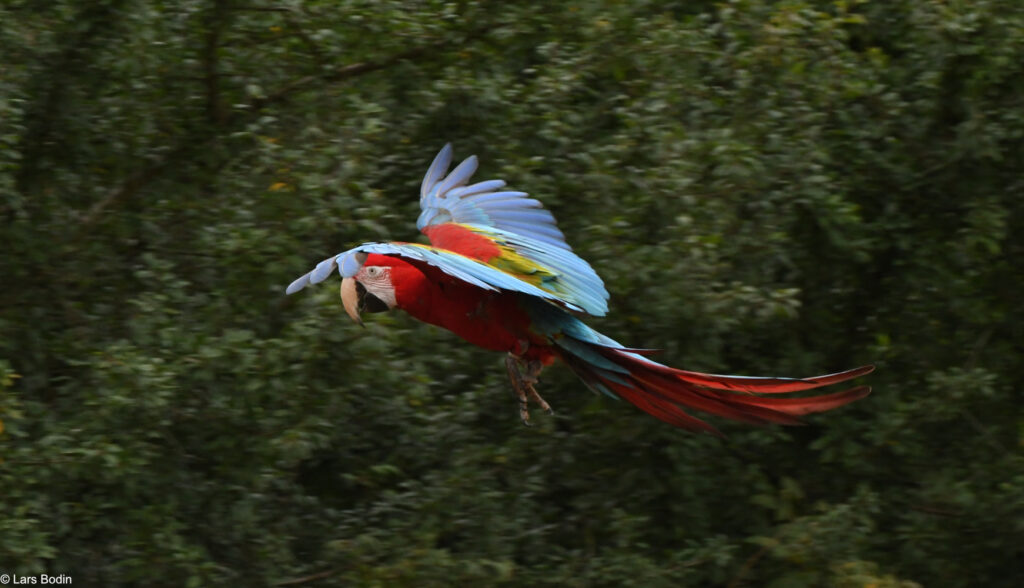Ara chloropterus – Red-and-green Macaw
With a length of 90-95 cm and a wingspan of 125 cm the Red-and-green Macaw (Ara chloropterus) is the largest of the macaws in the Ara genus; only the Hyacint Macaw (Anodorhynchus hyacinthinus) is larger (length: 100 cm) and the Kakapo is heavier. It was first described by the English zoologist George Robert Gray in 1859. It is also known as Green-winged Macaw.
They are very popular as pets and among breeders. They require a very strong cage or aviary as their powerful beak can easily destroy the wire mesh used for smaller species; also the aviary should be at least 10-15 m long to allow for flying. Provide plenty of bird-safe branches and toys to keep them occupied.
They can be very noisy when agitated but usually do not scream for extended periods.
They bond strongly with their mate; a pair will stay together for their whole life.
With proper care the lifespan is about 60 years.
The population seems to be declining but not at an alarming rate as its habitat includes a very large range. It is listed as Least Concern on the IUCN Red List and included in CITES Appendix II and EU Annex B.
Description
Overall dark red plumage. The cheeks are bare white skin with rows of tiny red feathers. Back, gump and tail coverts are blue. The tail is dark red with blue tips. Dark blue primaries, middle wing coverts are green. The bill is large and powerful with a horn colored upper mandible with black on the sides; the lower mandible is grey/black. The eyes are yellow.
The female have similar colours but in general have a slightly smaller head.
Juveniles have similar colours as the adults but shorter tail; the lower mandible is grey with white at base; grey eyes.
Size: 90-95 cm
Weight: 1050-1708 g
Some may confuse the Red-and-green Macaw with the Scarlet Macaw (Ara macao) as they are both red in general; however the Red-and-green Macaw is larger, has a darker red colour, green middle wing coverts and red stripes in the bare white facial skin – the Scarlet Macaw has yellow middle wing coverts and lacks the red stripes in the bare facial skin.
Subspecies
None.
Habitat
ts natural habitat covers a large range from eastern Panama south-east of the Andes, to Bolivia, Brazil and Paraguay. It is widespread throughout much of the Amazon basin and locally distributed in Panama, Venezuela and Bolivia.
In the north of its range it is found in rainforest; in the southern and eastern part of their range they are found in more open and drier areas like upland forest, floodplain forest and dry woodlands. It is found up to 1400 m.
Require large trees with cavities for nesting but have also been reported to use crevices in rock faces for nesting.
They are usually seen in pairs or small flocks of 6-12 individuals. They may however be seen in flocks with up to 100 birds at feeding grounds; sometimes also seen in flocks with other macaws like Scarlet Macaw or Blue-and-yellow Macaw.
Diet
The wild diet consist mainly of nuts and fruit, especially Brazil nuts. They may also gnaw at the bark of deciduous trees which provide fibers and vitamins. They will also lick on clay that provide some important minerals.
They feed in the canopy while carefully on lookout for predators.
Aviculture
The Red-and-green Macaw generally mates for life. The nest is made in a hole in a tree. Breeding season is from November to May. If there is plenty of food they may breed a second time.
The nest box should be about 40 x 40 x 125 cm.
The breeding pair should be kept alone in the aviary until the chicks fledges.
The female lays 2-3 eggs that are incubated for about 27-28 days; the chicks fledge from the nest about 90-100 days after hatching.
The first breed of young macaws will often die due to the parents inexperience.
Taxonomy
- Order: Psittaciformes
- Family: Psittacidae
- Genus: Ara
Synonyms
- Danish: Mørkerød Ara, Grønvinget Ara
- English: Red-and-green Macaw, Green-winged Macaw
- French: Ara chloroptère
- German: Grünflügelara
- Portuguese: Arara-canga, Arara-piranga, Arara-verde, Arara-vermelha, Arara-vermelha-grande
- Spanish: Guacamaya Rojiverde, Guacamayo Aliverde, Guacamayo Rojo, Papagayo rojo
- Scientific: Ara chloropterus
IUCN Red List

https://dx.doi.org/10.2305/IUCN.UK.2016-3.RLTS.T22685566A93080287.en
Downloaded on 9 July 2021





